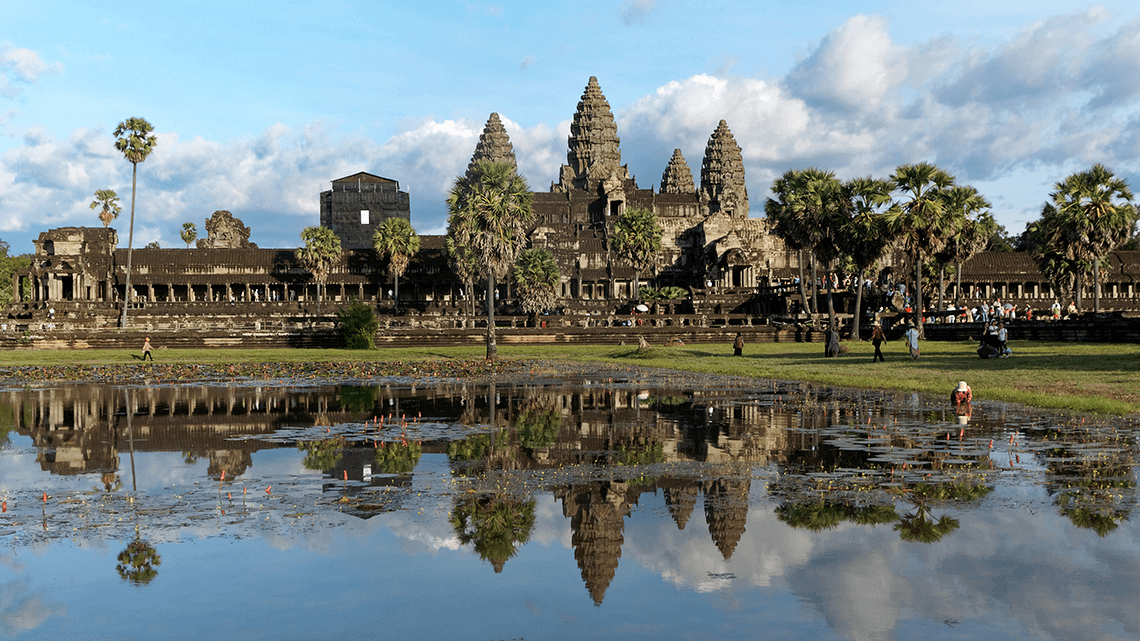ISABEL RUBIO ARROYO | Tungsteno
In the north of Cambodia, an architectural wonder emerges majestically from the forest: Angkor Wat. With more than 1,000 buildings and covering some 160 hectares, it is the largest religious structure in the world. Commissioned in the 12th century by the Khmer king Suryavarman II as a tribute to the Hindu gods Shiva, Brahma and Vishnu, it was erected in Angkor, then one of the most densely populated cities in the world, with an estimated one million inhabitants.
Sandstone blocks transported by canals
"Built as a recreation of the Hindu universe, its most striking features are the five sandstone towers that rise above the four temple enclosures, representing the peaks of Mount Meru, the centre of the universe," Alison Kira Carter, assistant professor of anthropology at the University of Oregon, tells The Conversation about the temple, which is surrounded by a large moat.
Sandstone blocks are the main material used in its construction. A decade ago, a team of researchers found more than 50 sandstone quarries in an escarpment at the foot of Mount Kulen, about 35 kilometres northeast of the Angkor monuments. They also identified a route of interconnected canals and rivers that were probably used to transport the sandstone blocks to the construction site, according to research published in the Journal of Archaeological Science.
Bricks were also used in the construction of Angkor Wat. The type of clay used and the conditions under which the bricks were fired produce a wide range of colours: whitish, yellow, red, grey or even black. "The bricks were bound together with tight joints during the construction process," says a document published by UNESCO and the Authority for the Protection and Management of Angkor and the Region of Siem Reap (APSARA). These bricks were bonded to one another with only "a very thin layer of binding substance."
King Suryavarman II commissioned the construction of Angkor Wat in the 12th century. Credit: icon0 com
A full-fledged "hydraulic city"
Beginning in 1950, French archaeologist Bernard Philippe Groslier used ariel photographs to reconstruct the layout of the ancient cities of Angkor. He discovered the complexity of its water management system—consisting of a vast network of canals, dykes, ditches and reservoirs—and dubbed Angkor the 'Hydraulic City'. The water system played a key role in the rise of the empire, ensuring a year-round supply of water to sustain the population, agriculture and livestock.
"Angkor's hydraulic system is so unique because of its scale," explains Dan Penny, a researcher in the University of Sydney's geosciences department, to the BBC. He says there are many examples of historic cities with sophisticated water management systems, but "none like this." He points out, for example, the scale of the reservoirs: "The amount of water the West Baray holds is incredible. Many European cities could have comfortably sat within it when it was built. It's mind-boggling; it's a sea."
Angkor Wat was known for its sophisticated water management network. Credit: Science Channel
The decline of Angkor Wat
Despite the fact that this water management network "was really important in the growth of the city and led to wealth and power," it also had a downside: "As it grew more complex and larger and larger, it became the Achilles' heel to the city itself." In the late 14th and early 15th centuries, prolonged monsoon rains were followed by severe droughts. These drastic climatic changes affected the water management network, destroying parts of it, fragmenting it and rendering it inoperable, according to Penny.
It is thought that the pressure of major droughts, the collapse of the water management system, constant Siamese attacks and the expansion of sea routes all contributed to the fall of this great empire. These ancient temples were then hidden beneath the forest until they were found by the French naturalist and explorer Henri Mouhot. After extensive conservation work, Angkor Wat is now one of the most important pilgrimage sites in Southeast Asia and a popular tourist attraction.
· — —
Tungsteno is a journalism laboratory to scan the essence of innovation.
